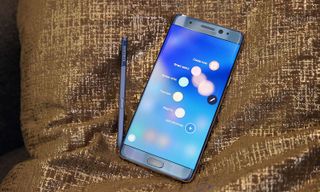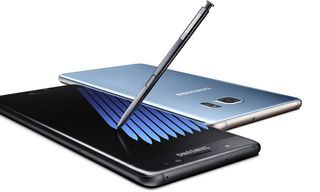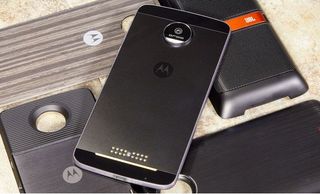7 Reasons I Won't Buy a Galaxy Note 7
Like most consumers, I'll hold onto my next smartphone for 2.5 to 3 years. Samsung's new flagship phone doesn't offer the key features I need today and in the future.
As the owner of a nearly three-year-old Samsung Galaxy Note 3, I'll probably be purchasing a new smartphone sometime this year. At first blush, the upcoming Galaxy Note 7 seems like the obvious upgrade for Note fans like me, because it offers the same large display, pen support and Samsung-style interface that I'm used to, along with better performance, a sharper screen and water resistance.
However, I wouldn't touch the Note 7 with a 10-foot stylus, because it doesn't have the features I need today nor those I'll want in a year or two, when I'll still be using my next handset.

When I was on a two-year contract and was entitled to a subsidized phone every two years, I'd upgrade like clockwork, because it would cost me only $200 to get a top-of-the-line handset. However, with the end of contracts, consumers like me are now on the hook for the full $879 price of the Note 7. I can space those payments out over a 24- to 30-month period, but I'm still spending the money.
Here are seven reasons I won't buy a Galaxy Note 7.
1. No Compelling New Capabilities
Unlike in the early days of smartphones, most of today's new models don't offer me the ability to do anything I can't do with my three-year-old-unit. In past years, when I upgraded, I moved from 3G to 4G, from a small screen to a big screen or from short to long battery life.
The Galaxy Note 7 offers iteratively better performance, display quality and photography than my current phone, but the new device doesn't offer me any new use cases. The phone adds the ability to pin notes to the display when it's off, scan your iris to unlock, create GIFs from videos and zoom in to any part of the screen. However, if you think any of these are going to change your phone-using life, you're very easily impressed. Say, is that a coin behind your ear?
MORE: Here Are the 10 Best Smartphones Available
2. Extremely Expensive
As I mentioned above, the Galaxy Note 7 costs as much as $879, depending on which carrier you buy the phone from. If this were the only good premium phone in town, it might be worth that price, but in reality, you can get a serviceable device for under $200 and a really good one for under $400.

Both Google's flagship phone, the Nexus 6P, and the gorgeous OnePlus 3 each cost $399. Lenovo's groundbreaking Phab 2 Pro, which is the first device with 3D cameras, retails for only $499. And you can get by just fine with the $199 Huawei Honor 5X. For nearly $900, the Note 7 should be twice as good as any of those competitors, but it's not.
3. The Pen Isn't Mightier Than the Finger
When I bought my Note 3, I thought I'd use its stylus to write notes at meetings or respond to emails on a daily basis. In reality, I've used the pen only twice in all the years I've had it. I found that even a 5.7-inch screen is just too small of a canvas for serious scribbling. And poking at an on-screen keyboard is faster and more accurate than drawing all those letters and hoping the system can interpret my terrible handwriting.

4. No Expansion
Expansion options like Motorola's "Moto Mods" and LG's "Friends" allow you to do a lot more than extend your battery life. You can turn your phone into a projector, add rich speakers or improve the camera experience. Samsung will sell some first-party accessories such as a battery case and a keyboard cover, but these aren't part of the phone.

Since I'm going to hold on to my next phone for at least 30 months, I want to be sure I can increase its functionality over time.
MORE: Moto Z Force and Z Droid Reviewed
5. Stuck with Marshmallow
Google is rolling out Android 7 "Nougat" this fall and, with the new OS, a whole slew of new features such as multiwindow mode, enhanced notifications and improved power management. The Note 7 will launch with Android 6 "Marshmallow," and eventually get an update to the new OS. Good luck with that. I'm not going to buy a phone until I get one with Android 7 on board out of the box.
Unfortunately, we know that most Android phones take months to get an OS update. Amongst phone manufacturers, most of whom are terrible at this, Samsung is one of the worst. Computerworld recently graded all the Android makers on their update speed, and Samsung got an F, because the company took 152 days to update the Galaxy Note 5 to Marshmallow and 158 days to update the Galaxy S6.
6. Have to Tango Elsewhere
Google's Project Tango is the next big thing in phone technology, using 3D cameras to map your environment for immersive augmented reality and measuring real-world objects. If you think the AR in Pokemon Go is cool, just wait until your phone can make that Jigglypuff across the room look like it's really climbing up the dresser.

In order to run Tango-enabled apps, you need a phone with a set of 3D cameras, and the only handset with that capability right now is Lenovo's $499 Phab 2 Pro. There aren't a ton of Tango apps right now, but in a year or two, all the new phones will take advantage of this technology while your old Galaxy Note 7 is left out in the cold.
MORE: Lenovo's First Project Tango Phone Is An Augmented Reality Monster
7. No Shatterproof Screen
The Galaxy Note 7 is water-resistant, which would be nice if I wanted to take my phone swimming. However, it's more likely that I would drop the phone onto a hard surface than into a pool of liquid. Motorola has a technology called ShatterShield on its Moto Z Force that protects the screen from cracks, even under serious abuse.
This technology first appeared on the Droid Turbo 2, which we dropped from 5 feet onto concrete, wood and tile, without it getting a scratch. Having this level of durability should be table stakes for a flagship phone in 2016, but unfortunately only Motorola has thus far stepped up to the table.
Sign up to get the BEST of Tom’s Guide direct to your inbox.
Upgrade your life with a daily dose of the biggest tech news, lifestyle hacks and our curated analysis. Be the first to know about cutting-edge gadgets and the hottest deals.
